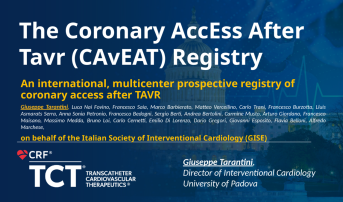Protecting Coronary Access After TAVI: Valve Choice Clues From CAVEAT
Evolut Pro/Pro+ valves had the lowest rate of cannulation, but next-gen devices are poised to overcome access challenges.

WASHINGTON, DC—Amid growing calls to consider coronary access as part of heart team discussions, a new analysis is shining a light on which devices will not impair subsequent coronary procedures and which may pose tricky challenges. According to results from the CAVEAT study, the short-frame, balloon-expandable Sapien 3 and Sapien Ultra (Edwards Lifesciences) transcatheter heart valves had the highest rates of preserved left and right coronary cannulation compared with other commonly used valves.
Among valves with taller frames, the Portico/Navitor (Abbott) and Acurate Neo/Neo2 (Boston Scientific) devices both resulted in better access to the coronary arteries when compared with the Evolut Pro/Pro+ (Medtronic) transcatheter valve with its closed-cell design, report investigators.
Giuseppe Tarantini, MD, PhD (University of Padua Medical School, Italy), who presented the results during the WorldLink Forum at TCT 2024, emphasized that younger and younger low-risk patients are now undergoing TAVI and said there is increased recognition about the need to preserve coronary access.
“We need to save the coronary [access] and we struggle do that,” said Tarantini. With tall frame transcatheter heart valves, “if the valve is implanted very deep and you do not orientate the valve, you might have some problems with coronary cannulation, unless you have a very wide ascending aorta and you can cannulate from outside, although this is only a rescue mechanism.”
Lifetime management has become a buzz phrase in the decision-making for patients with symptomatic, severe aortic stenosis. This means not just anticipating the need for a second valve if the first fails down the road, but also taking into account the importance of coronary access to treat CAD should it be necessary. As a result, operators now focus on commissural alignment to decrease the risk of coronary obstruction with transcatheter valves and there is even a new dedicated device (ShortCut; PiCardia) to facilitate leaflet splitting with valve-in-valve procedures to prevent coronary obstruction.
Vinicius Esteves, MD, PhD (Rede D'Or São Luiz, São Paulo, Brazil), one of the panelists during the session, emphasized the importance of tailoring valve selection to the patient.
“There's not one valve that fits everyone, every patient,” he told TCTMD. “We have to individualize patient characteristics, patient anatomy, and the device characteristics to pick the best device for each one. This is why it’s important not to work with one device, but with multiple devices.”
Esteves said that if a patient presents with CAD prior to TAVI, they might be more likely to use a shorter frame transcatheter heart valve, such as the Sapien device, but that depends on the patient’s anatomy.
“But then you go to the other side, which is hemodynamics,” he said. “With the data we have today with small annuli, if you put this type of valve in a female, just like in the SMART trial, then you probably have worse outcomes in terms of hemodynamics and structural valve deterioration even though you have better coronary access.”
The relative importance of new conduction disturbances also needs to be factored in, said panelist Soledad Ojeda, MD, PhD (Reina Sofia Hospital, Córdoba, Spain). Clinicians, she said, typically want to implant the valve very high to avoid the risk of conduction disturbances and need for permanent pacing, but “that can mortgage the future” by complicating coronary access.
Prior studies have demonstrated that the tall-frame, self-expanding devices have greater challenges with coronary access than the short-frame Sapien devices, though there have been limited data with Portico/Navitor and Acurate Neo/Neo2. These latter transcatheter heart valves have an open-cell design which facilitates better access than the early-generation Evolut valves.
Best Access With Sapien 3/Ultra
The primary endpoint of the study was a core laboratory-based definition of coronary access, with selective access defined as the tip of the catheter remaining within the coronary lumen steadily during image acquisition. With nonselective coronary access, the coronary artery was visible but the catheter remained outside the coronary ostium, while unfeasible access was defined as the inability to visualize the coronary artery.
“I think one point that needs to be mentioned is the [choice of] coronary catheter was left at the operator discretion, up to a maximum of three,” said Tarantini. “Diagnostic or guiding catheters were allowed, but no use of guidewires or guide-extension catheters were allowed for this study and no time or contrast limits were included in the protocol.”
Successful coronary cannulation of the left and right coronary arteries occurred in 89% of patients treated with Sapien 3/Ultra. With Portico/Navitor, Acurate Neo/Neo2, and Evolut Pro/Pro+, successful cannulation of both arteries occurred in 63%, 62%, and 45%, respectively. The rates of unfeasible cannulation of either artery were 2%, 6%, 6%, and 9% in those treated with Sapen3/Ultra, Portico/Navitor, Acurate Neo/Neo2, and Evolut Pro/Pro+, respectively.
When comparing devices head-to-head, Sapien 3/Ultra was significantly better than all three other valves for achieving left and right coronary access. Among the tall-frame valves alone, there was no difference in successful cannulation rates between Portico/Navitor and Acurate Neo/Neo2, and both of these devices were significantly better than the Evolut Pro/Pro+.
Looking only at left coronary access, Sapien 3/Ultra was significantly better than all the other valves: 95% successful cannulation versus 88%, 85%, and 74% with Portico/Navitor, Acurate Neo/Neo2, and Evolut Pro/Pro+, respectively. Again, there was no difference between Portico/Navitor and Acurate Neo/Neo2, and both were better than Evolut Pro/Pro+ for accessing the left coronary artery. The differences between valves were less pronounced with right coronary access.
More Data to Come
Tarantini said that the rate of completely unfeasible coronary access was low overall, which is reassuring, but he pointed out that unfeasible access after TAVI was ten times higher with the right than left coronary artery (5.5% vs 0.5%, respectively).
“For the right coronary artery, all the tall-frame valves are pretty much the same,” said Tarantini. “There was not too much difference.”
Tarun Chakravarty, MD (Cedars-Sinai Medical Center, Los Angeles), pointed out that there is likely some selection bias in CAVEAT, with patients considered to have challenging anatomy being more likely to receive Sapien3/Ultra valves. He also noted that these were high-volume structural operators, and coronary access might be worse in less experienced centers. “There, the challenges might be even more pronounced,” he said.
While the Evolut Pro/Pro+ device performed poorest with respect to coronary access, Esteves noted that US and European regulators have approved two newer iterations: Evolut FX and Evolut FX+. The newest FX+ device, approved just days ago in Europe and earlier this year in the US, has three large coronary access windows that are significantly bigger than the regular cells of the Evolut devices, he said.
“This will facilitate even better coronary access,” said Esteves. “You can do commissural alignment with the same technique because you have the markers at the bottom of the valves and then you have a large, wide-open cell right in front of the coronaries.”
Next month at PCR London Valves 2024, investigators will present the results of CANNULATE TAVR, a study looking at coronary access and commissural alignment with the Evolut FX device.
Michael O’Riordan is the Managing Editor for TCTMD. He completed his undergraduate degrees at Queen’s University in Kingston, ON, and…
Read Full BioSources
Tarantini G, Fovino, LN, Saia F, et al. The coronary access after TAVR registry: an international, multicenter, prospective registry of coronary access after TAVR. Presented at: TCT 2024. October 27, 2024. Washington, DC.
Disclosures
- Tarantini reports lecture fees from Abbott, Edwards Lifesciences, Medtronic, GADA, Abiomed, Boston Scientific, Microport, and SMT.
- Ojeda reports speaking fees from Philips and Medtronic and consulting fees from Edwards Lifesciences, Abbott, and Boston Scientific.
- Chakravarty reports consulting fees from Edwards Lifesciences, Boston Scientific, and Medtronic.
- Esteves reports no conflicts of interest.






Comments